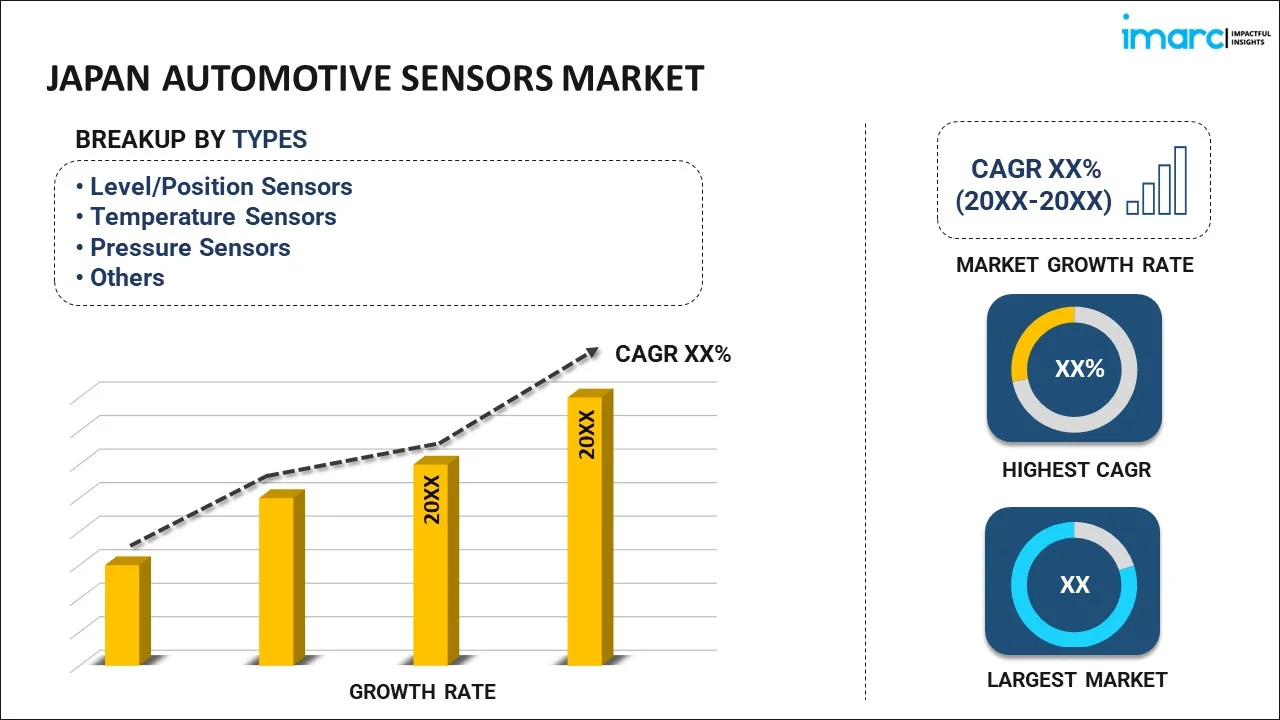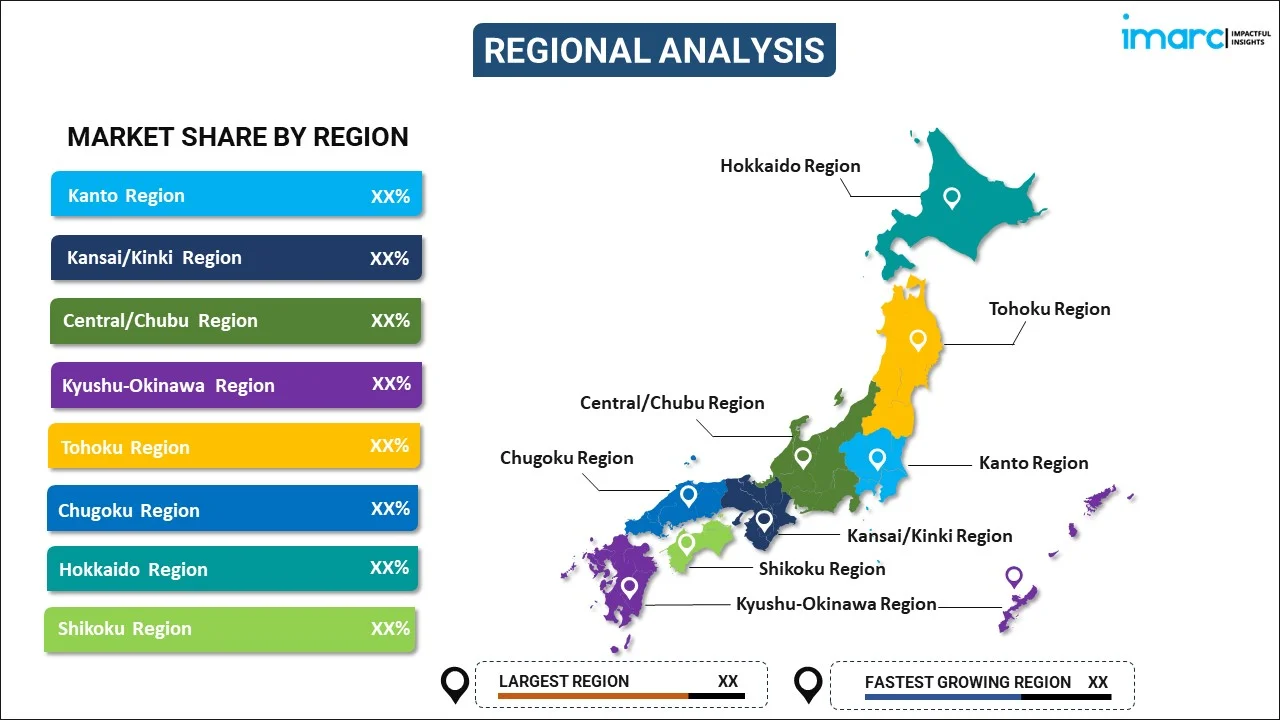
Japan Automotive Sensors Market Report by Type (Level/Position Sensors, Temperature Sensors, Pressure Sensors, Speed Sensors, Gas Sensors, Magnetic Sensors, and Others), Vehicle Type (Passenger Cars, Commercial Vehicles), Application (Powertrain, Chassis, Vehicle Body Electronics, Safety and Security, Telematics, and Others), Sales Channel (Original Equipment Manufacturer (OEM), Aftermarket), and Region 2025-2033
Market Overview:
Japan automotive sensors market size reached USD 1.7 Billion in 2024. Looking forward, IMARC Group expects the market to reach USD 2.9 Billion by 2033, exhibiting a growth rate (CAGR) of 5.9% during 2025-2033. The growing trend of connected vehicles and the Internet of Things (IoT), which has led to increased sensor integration in vehicles for features like remote diagnostics, real-time monitoring, and vehicle-to-vehicle communication, is primarily driving the market.
|
Report Attribute
|
Key Statistics
|
|---|---|
|
Base Year
|
2024 |
|
Forecast Years
|
2025-2033 |
|
Historical Years
|
2019-2024
|
| Market Size in 2024 | USD 1.7 Billion |
| Market Forecast in 2033 | USD 2.9 Billion |
| Market Growth Rate (2025-2033) | 5.9% |
Automotive sensors, known as intelligent sensors, play a pivotal role in monitoring and managing various critical aspects of a vehicle's performance. These sensors encompass a range of functionalities, including temperature, oil pressure, emissions, and coolant level measurements. Within this category, sensors are designed to gauge factors like temperature, gas composition, speed, pressure, and magnetic fields. These sensors are seamlessly integrated with a vehicle's computer system, enabling them to perform complex calculations, such as determining air density within the engine. One of their key functions is to keep a close eye on the crankshaft's rotational speed, which is instrumental in controlling fuel injection and engine timing, ensuring optimal engine performance. Additionally, automotive sensors are instrumental in monitoring exhaust gas composition, specifically the oxygen content, which is crucial for devising effective fuel metering strategies and emission control measures. Furthermore, these sensors contribute to the efficient combustion of fuel, preventing potential damage to critical engine components like rings, head gaskets, and rod bearings. They also exert control over various vehicle functions, including activating or deactivating systems like early fuel evaporation (EFE), spark advance adjustment, canister purge, and exhaust gas recirculation (EGR).
Japan Automotive Sensors Market Trends:
The growth of the automobile sensors market in Japan is primarily driven by several key factors. Firstly, the increasing emphasis on vehicle safety has spurred the demand for advanced sensor technologies. With governments in Japan imposing stringent safety regulations, automakers are integrating sensors for collision avoidance, lane departure warnings, and adaptive cruise control. Consequently, these safety-oriented sensors have witnessed a surge in adoption. Furthermore, the rise of autonomous vehicles is another pivotal driver. Self-driving cars heavily rely on a plethora of sensors, including LiDAR, radar, and cameras, to navigate and make real-time decisions. As the autonomous vehicle industry continues to evolve, so does the demand for these sensors, bolstering market growth. Moreover, the ongoing trend toward environmental sustainability has propelled the adoption of sensors for emissions control and fuel efficiency optimization. Automakers are increasingly turning to sensor technologies to comply with stringent emission standards and meet the rising demand for eco-friendly vehicles. In addition to these factors, the growing consumer preference for advanced driver assistance systems (ADAS) and in-vehicle infotainment systems further fuels the market. As technology advances and consumer expectations rise, the demand for automobile sensors in Japan is set to continue its upward trajectory, making it a lucrative industry for both established players and newcomers.
Japan Automotive Sensors Market Segmentation:
IMARC Group provides an analysis of the key trends in each segment of the market, along with forecasts at the country level for 2025-2033. Our report has categorized the market based on type, vehicle type, application, and sales channel.
Type Insights:

- Level/Position Sensors
- Temperature Sensors
- Pressure Sensors
- Speed Sensors
- Gas Sensors
- Magnetic Sensors
- Others
The report has provided a detailed breakup and analysis of the market based on the type. This includes level/position sensors, temperature sensors, pressure sensors, speed sensors, gas sensors, magnetic sensors, and others.
Vehicle Type Insights:
- Passenger Cars
- Commercial Vehicles
A detailed breakup and analysis of the market based on the vehicle type have also been provided in the report. This includes passenger cars and commercial vehicles.
Application Insights:
- Powertrain
- Chassis
- Vehicle Body Electronics
- Safety and Security
- Telematics
- Others
The report has provided a detailed breakup and analysis of the market based on the application. This includes powertrain, chassis, vehicle body electronics, safety and security, telematics, and others.
Sales Channel Insights:
- Original Equipment Manufacturer (OEM)
- Aftermarket
A detailed breakup and analysis of the market based on the sales channel have also been provided in the report. This includes original equipment manufacturer (OEM) and aftermarket.
Regional Insights:

- Kanto Region
- Kansai/Kinki Region
- Central/ Chubu Region
- Kyushu-Okinawa Region
- Tohoku Region
- Chugoku Region
- Hokkaido Region
- Shikoku Region
The report has also provided a comprehensive analysis of all the major regional markets, which include Kanto Region, Kansai/Kinki Region, Central/ Chubu Region, Kyushu-Okinawa Region, Tohoku Region, Chugoku Region, Hokkaido Region, and Shikoku Region.
Competitive Landscape:
The market research report has also provided a comprehensive analysis of the competitive landscape. Competitive analysis such as market structure, key player positioning, top winning strategies, competitive dashboard, and company evaluation quadrant has been covered in the report. Also, detailed profiles of all major companies have been provided.
Japan Automotive Sensors Market Report Coverage:
| Report Features | Details |
|---|---|
| Base Year of the Analysis | 2024 |
| Historical Period | 2019-2024 |
| Forecast Period | 2025-2033 |
| Units | Billion USD |
| Scope of the Report | Exploration of Historical Trends and Market Outlook, Industry Catalysts and Challenges, Segment-Wise Historical and Future Market Assessment:
|
| Types Covered | Level/Position Sensors, Temperature Sensors, Pressure Sensors, Speed Sensors, Gas Sensors, Magnetic Sensors, Others |
| Vehicle Types Covered | Passenger Cars, Commercial Vehicles |
| Applications Covered | Powertrain, Chassis, Vehicle Body Electronics, Safety and Security, Telematics, Others |
| Sales Channels Covered | Original Equipment Manufacturer (OEM), Aftermarket |
| Regions Covered | Kanto Region, Kansai/Kinki Region, Central/ Chubu Region, Kyushu-Okinawa Region, Tohoku Region, Chugoku Region, Hokkaido Region, Shikoku Region |
| Customization Scope | 10% Free Customization |
| Post-Sale Analyst Support | 10-12 Weeks |
| Delivery Format | PDF and Excel through Email (We can also provide the editable version of the report in PPT/Word format on special request) |
Key Questions Answered in This Report:
- How has the Japan automotive sensors market performed so far and how will it perform in the coming years?
- What has been the impact of COVID-19 on the Japan automotive sensors market?
- What is the breakup of the Japan automotive sensors market on the basis of type?
- What is the breakup of the Japan automotive sensors market on the basis of vehicle type?
- What is the breakup of the Japan automotive sensors market on the basis of application?
- What is the breakup of the Japan automotive sensors market on the basis of sales channel?
- What are the various stages in the value chain of the Japan automotive sensors market?
- What are the key driving factors and challenges in the Japan automotive sensors?
- What is the structure of the Japan automotive sensors market and who are the key players?
- What is the degree of competition in the Japan automotive sensors market?
Key Benefits for Stakeholders:
- IMARC’s industry report offers a comprehensive quantitative analysis of various market segments, historical and current market trends, market forecasts, and dynamics of the Japan automotive sensors market from 2019-2033.
- The research report provides the latest information on the market drivers, challenges, and opportunities in the Japan automotive sensors market.
- Porter's five forces analysis assist stakeholders in assessing the impact of new entrants, competitive rivalry, supplier power, buyer power, and the threat of substitution. It helps stakeholders to analyze the level of competition within the Japan automotive sensors industry and its attractiveness.
- Competitive landscape allows stakeholders to understand their competitive environment and provides an insight into the current positions of key players in the market.
Need more help?
- Speak to our experienced analysts for insights on the current market scenarios.
- Include additional segments and countries to customize the report as per your requirement.
- Gain an unparalleled competitive advantage in your domain by understanding how to utilize the report and positively impacting your operations and revenue.
- For further assistance, please connect with our analysts.
 Inquire Before Buying
Inquire Before Buying
 Speak to an Analyst
Speak to an Analyst
 Request Brochure
Request Brochure
 Request Customization
Request Customization




.webp)




.webp)












